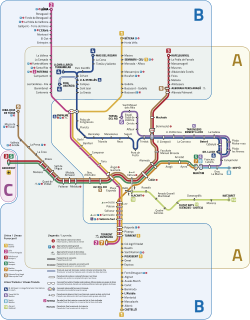Metro Valencia
 |
|||
| Overview | |||
|---|---|---|---|
| Owner | FGV | ||
| Locale | Valencia, Spain | ||
| Transit type |
Rapid transit Tram |
||
| Number of lines |
9
|
||
| Number of stations |
137
|
||
| Annual ridership | 62,631,756(2016) | ||
| Chief executive | Mario Flores Lanuza | ||
| Operation | |||
| Began operation | 8 October 1988 (as FGV) 5 May 1995 (as MetroValencia) |
||
| Number of vehicles | 108 | ||
| Technical | |||
| System length |
156.4 km (97.2 mi)
|
||
| Track gauge | 1,000 mm (3 ft 3 3⁄8 in) metre gauge | ||
| Electrification | 750 V DC 1500 V DC, overhead wire |
||
|
|||
9
137
156.4 km (97.2 mi)
Metrovalencia is a modern amalgamation of former FEVE narrow gauge diesel and electric operated suburban/regional railways. It is a large suburban network that crosses the city of Valencia, with all trains continuing out to far-flung suburbs. It also has destinations on lines that make it more closely resemble commuter trains. The unique system combines light railway, metro and several tram operations north of the Túria riverbed park with line 4. Trains of lines 1, 3, 5 and 9 have automatic train operation (ATO) in 25.3 kilometers of underground system. Tram lines 4, 6 and 8 are operated by modern trams.
This network consists of more than 156.4 kilometres (97.2 mi) of route, of which 27.3 kilometres (17.0 mi) is underground.
The system authority Ferrocarrils de la Generalitat Valenciana (FGV) uses bilingual signage in Valencian and Spanish.
† Notes: In 1998, Line 2 was combined with Line 1; it became a separate branch again in 2015. Lines 7 to 9 were created in 2015 by splitting existing branch lines, with the only new stations for these lines consisting of the extension from Manises to Riba-roja de Túria.
The network includes five unmanned stations: Rocafort, Fuente del Jarro, Massarojos, Benaguasil 1 and Font de l´Almaguer.
In 2012, an estimated 63,103,814 passengers used the service, a decline of 2.8% from the 65,074,726 who had used it in 2011. The 2011 figures had shown a 5% decline compared to 2010. On average 172,887 passengers a day used the service in 2012 with the busiest day being 18 March, the final day of the Fallas festival, when 482,960 passengers used the service. The three most used stations on the network were all in the centre of Valencia: Xàtiva, beside Valencia's main train station, with 4,769,628 passengers in 2012, Colón, in one of Valencia's main shopping streets, with 4,189,736 passengers and Àngel Guimerà, an interchange station for lines 1,4 and 5 situated beside Valencia old town, with 2,461,012 users. The fourth and fifth busiest stations were Túria, next to Valencia's main bus station, with 2,035,521 and Facultats, serving the University of Valencia, with 1,951,080 users. The remaining stations in the top eight were Plaça de Espanya (1,807,538 passengers), Amistat (1,552,281) and Mislata (1,505,106). The first two of these were located in areas near Valencia centre, while Mislata was the main station for the satellite town of the same name.
...
Wikipedia

